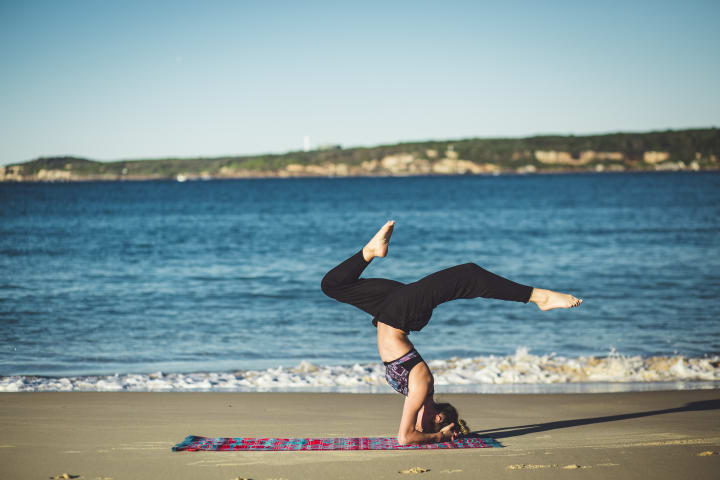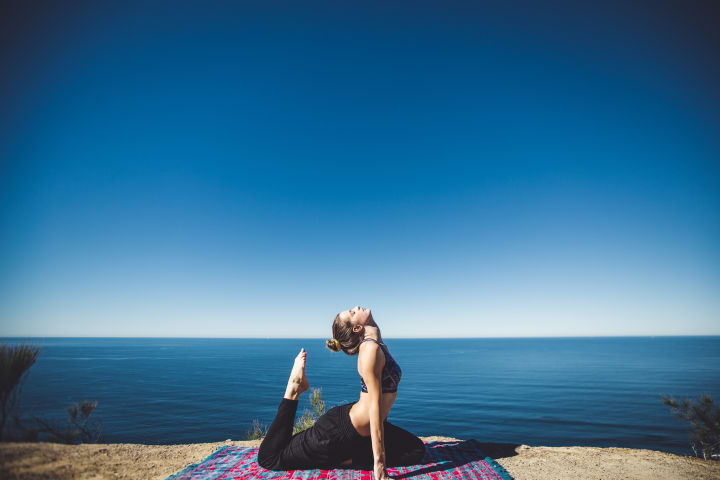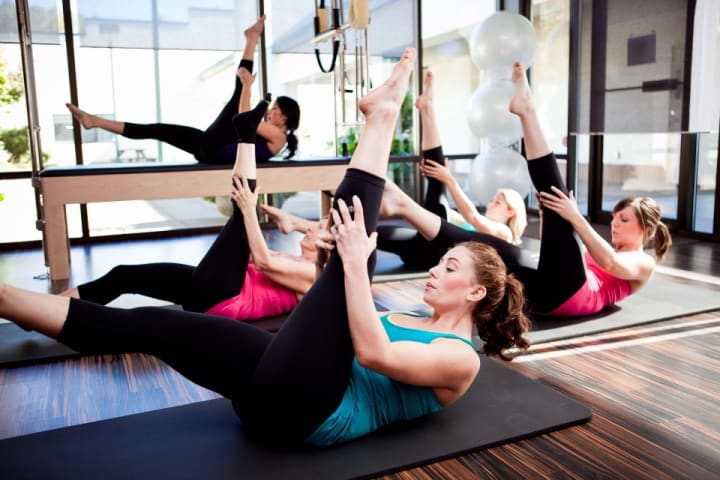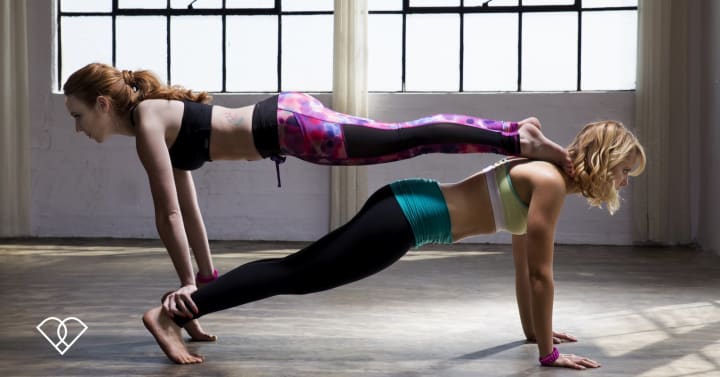Yoga Vs Pilates
A closer look at the purpose and benefits of two of the coolest ways to work out.

I am qualified to teach both Yoga and Pilates, and though my preference, by and large, is Yoga, I am going to try and make this as non-biased as possible. I began my Yoga journey 8 years ago but Pilates is fairly new to me. Frequently thrown into the same pot, I think most people are under the impression that Yoga and Pilates are exactly the same. I was also under this impression. Largely because, when I began training to teach Yoga, my school offered me a discounted rate on the Pilates course based on the fact I would already have the required anatomy and physiology certificates to go forward with another course. At first I didn’t want to, I had never taken a Pilates class in my life and didn’t think it would be possible to learn an entirely new skill alongside learning to teach it. However, I was assured that Pilates was EXACTLY like Yoga and that the qualifications went hand in hand. A lot of Studios look for teachers qualified in both.
Whilst that may be the case, the story that the two are exactly the same could not be further from the truth. So for those of you who take both, or take one and are curious about the other, or those of you who have never taken either! I’m going to attempt to break down the benefits, purposes and differences between Yoga and Pilates.
Yoga - Purpose & Benefits

The ultimate purpose of Yoga, according to the ancient practice, is to achieve a ‘Higher state of being’, whilst the more spiritual yogis do still strive for this goal, in modern yoga the focus is slightly shifted. Yoga is now prescribed by doctors to those suffering with aches, pains, stresses or anxiety. It has become the trendy way to stay in shape, both mentally and physically, with a Yoga studio popping up on every street corner of the hipster hangouts in East London and every empty warehouse in Downtown LA.
Though there are many different types of yoga practice, ranging from Bikram (structured as a physical work out) to Jivamukti (which concentrates on meditation) or practices like Kundalini that sit in the middle and take a little from both, ultimately the goals are pretty much the same, you achieve mental clarity (even if only for an hour), relaxation, increased flexibility and to a smaller extent, weight loss. Yoga is not a substitute for a weights session or a spin class, if your goal is ultimately to shift a lot of weight then by all means keep doing it but throw in some other work outs also.
Yoga is, for me, the best part of my day. It is an hour of me time that I can completely relax without my phone, work worries, social media and dogs jumping all over me. I recently started practicing at a studio in Haggerston that is under the arches of the railway and lit by candles, it has an energy that instantly makes me melt into my practice with ease but their teachers push the classes hard so, whilst I relax, my body feels stretched and worked to its fullest. I am a true believer that everyone can benefit from Yoga, after seeing how it alters my stress levels in just one hour, who wouldn’t want that? Especially when we live in such a fast paced, busy world.
If you’re not convinced I’ve broken down a few popular types of Yoga available to all you curious Yogis out there (I’m only going to write about a few as we haven’t got all day)
Bikram Yoga

The premise of Bikram Yoga is a precise 26 posture class, with two breathing exercises, practised over a 90 minute period, in what is essentially a sauna. Each posture is practiced twice in a row whilst you sweat out all the toxins in your body. The first class I ever took, I didn’t realise I would look like I had jumped in a swimming pool and hadn’t brought clothes to change into when I was done. I had to get the train home in the freezing cold, soaked in my own sweat with my nice new coat over the top, overly aware of how bad I must look and smell. ALWAYS bring a towel and a spare set of clothes, and I recommend practicing in shorts and a sports bra. Thank me later.
Bikram is, to be honest, horrible. But that is my opinion, and I used to do it every single day. My first class I nearly blacked out from the heat and I didn’t think I would make it through, but I did and I came back the next day and the next. Although I dreaded the class everyday, for some reason I became addicted to it. The purpose of the class is to detoxify, destress, stretch, tone, and heal chronic pain such as arthritis, joint aches, knee injuries and back problems.
I also see Bikram as a test. Each class is SO hard it’s like a test to yourself if you can complete it. I frequently want to leave in the middle of practice, but I get through it by counting the poses. Because each class is exactly the same in length and postures, once you know the sequence it’s easy to know how much you have left to do.
Bikram is the Yoga class where I see the most male presence, I notice more and more men taking Yoga, which I think is amazing, but Bikram is definitely the most masculine class, along with Ashtanga. I don’t know if it’s to do with the stamina needed to complete each class or the difficulty of attempting these postures whilst pouring sweat, that makes it more of a mens challenge, but I welcome the fact more men are turning to Yoga as a form of exercise and stress relief.
Ashtanga

Ashtanga Yoga is a system of yoga that involves synchronising the breath with a series of progressive postures, producing intense internal heat and a profuse, purifying sweat that detoxifies muscles and organs. The result is improved circulation, a light and strong body, and a calm mind.
Ashtanga, much like Bikram, is pretty hardcore and definitely not for beginner Yogis. To perform asana correctly in Ashtanga yoga, one must incorporate a mini vinyasa, so for example, after a set of postures you must then go down through chaturanga (similar to a press up) into cobra or upward facing dog and push back into down dog. This mini Vinyasa is incorporated throughout the class (Ashtanga classes are usually around 90 minutes but can be less) Ashtanga is really, really hard… and I’ve been practicing for almost a decade! Putting your mini Vinyasa in-between postures becomes incredibly weakening after 90 minutes of intense practice, toward the end of the class my arms usually want to give up the ghost and just hang back in child's pose.
That being said, I have never once left an Ashtanga class feeling like I haven’t done anything, and I am always proud of myself for taking one, when I see it on a schedule at my studio for the one time slot I can make that day, I usually skip it, even though it is the most rewarding feeling to complete.
Hatha

The word hatha means willful or forceful. But can be literally translated as “Ha” - sun and “tha”- moon. Which refers to the balance between the masculine and feminine aspects in all of us. Hatha yoga is a sequence of asanas, designed to align your skin, muscles, and bones and to open the many channels in the body to allow energy to flow freely.
Today Hatha is used to describe a generic, basic Yoga class with no flow between poses. Mostly recommended for beginners so they can get the gist of what Yoga and asana is about, learn how to practice Yogic breath and be introduced to postures and their sanskrit names.
The modern day version of Hatha Yoga is a great learning tool, it was my first Yoga class and even from just one class, because each posture is practiced as an individual pose, I learnt the names and how to correct certain faults, almost immediately.
Vinyasa Flow

Vinyasa, also called flow because of the smooth way that the poses run together, is one of the most popular contemporary styles of yoga. Each movement in the series is cued by an inhalation or an exhalation of the breath. This is the Yoga style I teach most frequently, and it is my favourite to practice. This might be because I am a kinaesthetic learner, which means I learn by doing. I also have the attention span of a flea, so I prefer to be moving and flowing the entire class, holding a posture for a long period of time or waiting for the teacher to demonstrate doesn’t work for me personally.
Vinyasa is a beautiful style of Yoga, it could almost be a dance, I love to watch the flow of certain teachers, for me it is the most calming and relaxing. Maybe because the constant movement between postures doesn’t give me time to think about anything other than my asana. Each teacher has their own style or flow and I enjoy thinking of a Vinyasa class and deciding how each posture runs into the next and looking at how other teachers make their flow work.
At the end of every yoga class there is a practice of meditation and/or relaxation, this can either be practiced sat cross legged or laying down on the mat in svasana. After a Vinyasa class of constant movement the feeling of stillness coming over the body is so rewarding.
Pilates - Benefits, Purposes & Differences

photo credit - Pop Pilates
Pilates was developed by Joseph Pilates in the 1900’s, it is a mind/body intervention that focuses on the 6 core principles: Strength, core stability, flexibility, muscle control, posture and breathing. So, much like Yoga, Pilates encompasses breathing into each posture and works to increase flexibility and strength, but Pilates is less about the spiritual and more about the physical. Used to correct bad posture and increase core strength, I learnt more about my core and balance over the time I was training to teach Pilates, than in my 8 years practicing Yoga. In fact, learning the correct way to align my body and use my core, helped with my Yoga practice even more than my Yoga teacher training.
In that respect, I can see why Yoga and Pilates are put hand in hand, but on the other side of the spectrum, they could not be more different. Where Yoga is a spiritual journey of relaxation, incorporating ancient religious practices and using the body and mind to flow through a journey of mindfulness and awakening the chakras. Pilates is more physically beneficial, especially for someone that suffers with poor body alignment or, like me, has bad posture due to spine problems. I am lordotic, which essentially means I arch my back consistently and that’s how I sit normally. It also means that my spine isn’t very strong and I rarely use my core. Before doing Pilates, I couldn’t do a headstand because my stupid curly spine would flail about like paper in the wind and I couldn’t support my legs without the help of a wall. Pilates taught me how to engage and use my core and pelvic floor muscles.

All that aside, the biggest difference between the two (for me anyway) is the breathing. If I am teaching Yoga and Pilates on the same day it can be incredibly confusing. Both practices use breathing to cue each exercise but, whilst Yoga encourages an inhale to begin and exhale, for example, to fold forward or lift back into down dog, Pilates, on the other hand (as though this is simply just to test my poor concentration) asks us to inhale to prepare for the posture and exhale to execute the pose. Pilates also teaches its students to inhale through the nose and exhale through the mouth, whilst both inhale and exhale are taken through the nose in Yoga.
Pilates is an incredibly feminine exercise, I have NEVER seen a male in any of my classes and there was not a single masculine presence on my course, where as Yoga is becoming more and more split between male and female students and teachers. I’m not sure if it is because Pilates is lighter than Yoga, doesn’t have the ancient spitritual history, or just that the exercises are more feminine (I feel a little like it is a slower more concentrated version of aerobics) Yet it’s strange that it was created by a man and no men seem to take part. I would love to see more men getting involved in the practice as it is an incredibly beneficial fitness tool for everyone. Correcting posture is more important today than it ever has been, we spend most of our time slouched on the sofa or hunched over a computer keyboard or a steering wheel. Taking an hour to learn about your body and create postural awareness is such a wake up call. I have always had a lordotic spine and gigantic boobs (oh poor me, big boobs and an arched, back I hear you say) It has actually caused me a lot of problems over the last decade or so because my spine is so weak and my shoulders are always hunched from carrying the weight of my boobs. Pilates has literally turned my posture around in only a few months of training and teaching, so I can’t wait to see what it does for me over the next couple of years.

Photo credit - Pop Pilates
Pilates is also getting a make over for the modern day, with practices and studios like ‘Pop Pilates’ taking the original postures and principles derived by Joseph Pilates and turning them into an upbeat workout that tones and corrects posture, but with the added element of working out to music. Very similar to aerobics but with more focus on the core and reworked for the modern women (or man).
About the Creator
Samantha Bentley
Born and Bred Londoner, Mother to baby Roman and my two pooches, Plant Eater, Yoga and Aerial Teacher + Learner, Music Maker... was once in Game Of Thrones, was once a Penthouse Pet, used to win awards for getting naked.






Comments
There are no comments for this story
Be the first to respond and start the conversation.